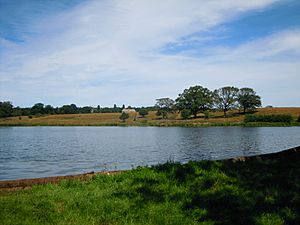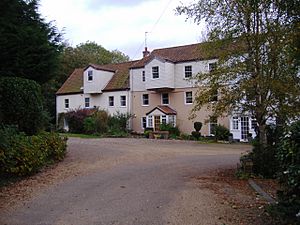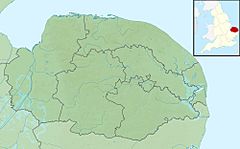Scarrow Beck facts for kids
Quick facts for kids Scarrow Beck |
|
|---|---|

Scarrow Beck on Hanworth Common
|
|
|
Location of the mouth within Norfolk
|
|
| Country | England |
| County | Norfolk |
| Region | East of England |
| District | North Norfolk |
| Physical characteristics | |
| Main source | In the Village of Aylmerton |
| River mouth | Merges with the River Bure 52°49′26.2″N 1°14′0.5″E / 52.823944°N 1.233472°E |
| Length | 12.4 km (7.7 mi) |
| Basin features | |
| Tributaries |
|
| Watermills Aldborough Erpingham Total Fall 51 meters from source to merger |
|
Scarrow Beck is a small stream in the northern part of Norfolk, a county in England. It's like a smaller river that flows into a bigger one. This type of smaller river is called a tributary. Scarrow Beck flows into the River Bure.
The stream starts from a spring in the village of Aylmerton, which is in North Norfolk. It flows for about 12.4 kilometers (7.7 miles). Finally, it joins the River Bure near Ingworth, close to the famous Blickling Hall estate.
Long ago, there were two watermills that used the power of Scarrow Beck. These mills are no longer working today. Another windmill, which is a different type of mill, stood on Gur Beck. Gur Beck is a smaller stream that flows into Scarrow Beck.
Contents
Where Scarrow Beck Begins
The spring where Scarrow Beck starts is in a wet, marshy area. This spot is in fields south of the Aylmerton church. The beck first flows east, then south, and then east again. It moves through a ditch made by people across open fields. These fields are near the National Trust estate of Felbrigg Hall.
When the beck reaches the edge of the estate, it goes into a culvert. A culvert is like a tunnel under a road. After this, it turns south and then southeast.
Felbrigg Pond
In the middle of the 1700s, Scarrow Beck was blocked by a dam. This created a lake called Felbrigg Pond. The pond was part of the beautiful gardens at Felbrigg Hall. Some people think that Humphry Repton, a famous landscape designer, might have helped create this pond. He lived nearby in 1778.

Journey Through the Countryside
From Felbrigg Pond, the beck flows out of the estate. It heads towards the village of Metton. It passes along the northern edge of the water works in the village. Here, it turns south and goes under a lane on the western side of Metton.
Again, people have made ditches for the beck to flow through. It crosses farm land where crops are grown. This is where a smaller stream called Gur Beck joins Scarrow Beck. Gur Beck comes from the village of Gresham.
About 200 meters (650 feet) after Gur Beck joins, Scarrow Beck flows through Big Fen Plantation. A plantation is an area of planted trees. After this, it appears on Hanworth Common. The beck then flows around the western side of the Common. Many small ditches, ponds, and wet spring areas add more water to it.
After going under Ringsbank Lane, the beck goes past some woods. It then fills several large, curved ponds in Thurgarton woods. The next village it reaches is Aldborough. South of this village, Scarrow Beck used to supply water to the first of the two watermills.
Aldborough Watermill
There has been a watermill at Aldborough for a very long time. Records show one existed even before the Domesday Book was written. The building you see today was built about 150 years ago. It is now a private home.
The large waterwheel that powered the mill was taken out around 1930. A diesel engine was used instead. In 1950, the Millpond, which held water from Scarrow Beck, was filled in. The beck itself was moved away from the mill buildings. Today, you cannot see any signs of the old water channel or the millpond.

Erpingham Watermill
The Erpingham watermill was taken down in 1965. It stood in a field on the eastern side of Scarrow Beck. This was between the villages of Calthorpe and Erpingham. This mill was known as the smallest watermill in Norfolk. It didn't work very well because Scarrow Beck didn't always have enough water for it.
The mill got its water from a channel that people dug by hand from the nearby beck. You can still see parts of this old channel in the field. The mill building was made of wood on a brick base. The upper part of the mill had wooden boards called shiplap weatherboarding. The roof was made with traditional red pantiles.
At one time, there was also a Smock windmill at this location. This windmill was also taken down around the 1890s. The Johnson family owned both mills for a while. They sold them around the year 1900 to a person named Mr. Witham.
Images for kids
-
The lake on the Felbrigg estate formed when the Scarrow Beck was barraged.
-
Aldborough Watermill today, now a private house






